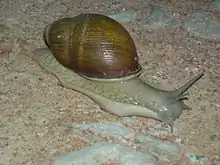Megalobulimus
Megalobulimus is a genus of air-breathing land snail, a terrestrial gastropod mollusk in the subfamily Megalobuliminae within the family Strophocheilidae (according to the taxonomy of the Gastropoda by Bouchet & Rocroi, 2005).
| Megalobulimus | |
|---|---|
 | |
| Megalobulimus parafragilior | |
| Scientific classification | |
| Kingdom: | |
| Phylum: | |
| Class: | |
| (unranked): | clade Heterobranchia clade Euthyneura clade Panpulmonata clade Eupulmonata clade Stylommatophora informal group Sigmurethra |
| Superfamily: | |
| Family: | |
| Subfamily: | Megalobuliminae Leme, 1973 |
| Genus: | Megalobulimus K. Miller, 1878[1] |
Megalobulimus is the type genus of the subfamily Megalobuliminae.
Species
Species within the genus Megalobulimus include (all species from Brazil are listed):[2]
- Megalobulimus abbreviatus (Bequaert, 1948)
- Megalobulimus albescens (Bequaert, 1948)
- Megalobulimus albus (Bland & Binney, 1872)
- Megalobulimus amandus Simone, 2012[3]
- Megalobulimus arapotiensis Lange-de-Morretes, 1952
- Megalobulimus auritus (Sowerby, 1838)
- Megalobulimus bereniceae (Lange-de-Morretes, 1952)
- Megalobulimus bertae Lange-de-Morretes, 1952
- Megalobulimus bronni (Pfeiffer, 1847)
- Megalobulimus capillaceus (Pfeiffer, 1855)
- Megalobulimus cardosoi (Lange-de-Morretes, 1952)
- Megalobulimus chionostoma (Mörch, 1852)
- Megalobulimus conicus (Bequaert, 1948)
- Megalobulimus elongatus (Bequaert, 1948)
- Megalobulimus foreli (Bequaert, 1948)
- Megalobulimus fragilion (Ihering, 1901)
- Megalobulimus garbeanus (Leme, 1964)
- Megalobulimus globosus (Martens, 1876)
- Megalobulimus grandis (Martens, 1885)
- Megalobulimus granulosus (Rang, 1831)
- Megalobulimus gummatus (Hidalgo, 1870)
- Megalobulimus haemastomus (Scopoli, 1786)
- Megalobulimus hector (Pfeiffer, 1857)
- Megalobulimus intertextus (Pilsbry, 1895)
- Megalobulimus jaguarunensis Fontenelle, Cavallari & Simone, 2014[4]
- Megalobulimus klappenbachi (Leme, 1964)
- Megalobulimus leonardosi (Lange-de-Morretes, 1952)
- Megalobulimus lopesi Leme, 1989
- Megalobulimus maximus (Sowerby, 1825)
- Megalobulimus mogianensis Simone & Leme, 1998
- Megalobulimus musculus (Bequaert, 1948)
- Megalobulimus nodai Lange-de-Morretes, 1952
- Megalobulimus oblongus (Müller, 1774)
- Megalobulimus oliveirai (Bequaert, 1948)
- Megalobulimus oosomus (Pilsbry, 1895)
- Megalobulimus ovatus (Müller, 1774)
- Megalobulimus parafragilior Leme & Indrusiak, 1990
- Megalobulimus paranaguensis (Pilsbry & Ihering, 1900)
- Megalobulimus pergranulatus (Pilsbry, 1901)
- Megalobulimus pintoi Lange-de-Morretes, 1952
- Megalobulimus popelairianus (Nyst, 1845) - synonym: Strophocheilus popelairianus
- Megalobulimus proclivis (Martens, 1888)
- Megalobulimus pygmaeus (Bequaert, 1948)
- Megalobulimus riopretensis Simone & Leme, 1998
- Megalobulimus rolandianus Lange-de-Morretes, 1952
- Megalobulimus sanctipauli (Ihering & Pilsbry, 1900)
- Megalobulimus terrestris (Spix, 1827)
- Megalobulimus valenciennesii (Pfeiffer, 1842)
- Megalobulimus vestitus (Pilsbry, 1926)
- Megalobulimus wohlersi Lange-de-Morretes, 1952
- Megalobulimus yporanganus (Ihering & Pilsbry, 1901)
- Species brought into synonymy
- Megalobulimus torii Lange-de-Morretes, 1937: synonym of Megalobulimus yporanganus (Ihering & Pilsbry, 1901)
Human use
Shells of terrestrial snails, mainly of the genus Megalobulimus, are found in fluvial shellmound (called sambaqui in Brazil) on the Capelinha archaeological site from paleoamerican culture of early Holocene.[5]
The shell of Megalobulimus sp. (local name: "churito") is used in the traditional ethnomedicine of Northwest Argentina when babies are hyperactive and cannot sleep well, then it is advised to put a shell under a pillow.[6]
References
- Miller K. (1878). Malak. Bl. 25: 172.
- (in Portuguese) Norma Campos Salgado & Arnaldo C. dos Santos Coelho. (2003). "Moluscos terrestres do Brasil (Gastrópodes operculados ou não, exclusive Veronicellidae, Milacidae e Limacidae)". Revista de Biología Tropical 51(Suppl. 3): 149-189. PDF Archived October 4, 2011, at the Wayback Machine. (with English abstract)
- Simone, L. R. L. (2012). "Taxonomical study on a sample of pulmonates from Santa Maria da Vitória, Bahia, Brazil, with description of a new genus and four new species (Mollusca: Orthalicidae and Megalobulimidae)". Papéis Avulsos de Zoologia. 52 (36): 431–439. doi:10.1590/S0031-10492012021600001.
- Fontenelle, J. H.; Cavallari, D.C.; Simone, L.R.L. "A new species of Megalobulimus (Gastropoda, Strophocheilidae) from Brazilian shell mounds" (PDF). Strombus. 21 (1–2): 30–37. Archived from the original (PDF) on 2015-04-02.
- Eggers S., Parks M., Grupe G. & Reinhard K. J. (2011). "Paleoamerican Diet, Migration and Morphology in Brazil: Archaeological Complexity of the Earliest Americans". PLoS ONE 6(9): e23962. doi:10.1371/journal.pone.0023962.
- Hilgert N. I. & Gil G. E. (2007). "Reproductive medicine in northwest Argentina: traditional and institutional systems". Journal of Ethnobiology and Ethnomedicine 3: 19. doi:10.1186/1746-4269-3-19.
Further reading
- Kawano T. & Moreira Leme J. L. (1994). "Chromosomes of three species of Megalobulimus (Gastropoda: Mesurethra: Megalobulimidae) from Brazil". Malacological review 27(1-2): 47-52.
- Borda V., Ramírez R. & Romero P. (2010). "Glándula pediosa de moluscos terrestres y sus implicancias evolutivas, con énfasis en Megalobulimus / Pediose gland in land snails and its evolutionary implications, with emphasis on Megalobulimus." Revista Peruana de Biología 17(1): . 43-52. PDF.
- Rodrigo Salvador, José Fontenelle, Barbara Mizumo Tomotani: Taxonomic reassessment of Megalobulimus toriii (Gastropoda, Strophocheilidae); Journal of Conchology issue 3 vol. 43 p 313-320, 2019.